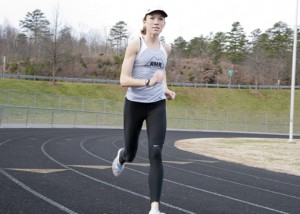At this point, there’s not much Louise Knudson can do besides stretch and rest.

Knudson, a 26-year-old UVA nurse, is running in the U.S. Olympic Trials marathon Saturday in Houston. We shared her story last year, after she qualified for the trials at the Boston Marathon.
Knudson is competing against 196 other women Saturday. She’ll have to finish in the top three to make the U.S. Olympic team.
When we talked to Louise in July, she wanted to increase her training mileage from 85 to 100 miles per week. She hoped to get her marathon time down from 2 hours and 42 minutes to a more competitive 2:30, a time she hoped would give her a good shot at competing with the country’s top female runners.
Now, she realizes that was too ambitious.
“My plan was to build my mileage up higher than it had ever been and do some shorter races to see how it goes,” she says. “Well, I got my mileage up to 100. The week after that, I sprained my foot.”
That was in early August. In a way, it was good timing. She’d planned to take a month off running beginning in September. Instead, she cross-trained for five weeks by running in the pool, which reduces stress on the joints and feet. After that, she rested for three weeks.
“It always drives you crazy to rest, but in every case I’ve seen, people who rest after an injury gain their fitness back very easily,” she says.
Charlottesville: A Runner’s City
Knudson’s attitude towards running is about having fun, setting personal goals and staying healthy. Many local running experts share that: they encourage focusing on personal goals and staying healthy rather than winning a race.
Charlottesville may be small, but runners have a lot of support here. Knudson trains through Ragged Mountain Racing, a local group of elite distance runners that provides training, funding and other support.
When Knudson first joined, one of Ragged Mountain’s founders, sports medicine doctor Robert Wilder, connected the runners with UVA’s Center for Endurance Sport (also known as the gait lab.)
The center is the only clinic in the U.S. that can evaluate three types of forces on the runner’s body and the runner’s range of motion. The staff then make recommendations based on where the forces could cause injury or poor running performance.
“Probably 75 to 80 percent of our patients have a specific nagging complaint that is not going away,” Center director Jay Dicharry says. “They’ve been to a number of healthcare providers who are unable to pinpoint the exact source of the issue, so they want to know, ‘Why is this happening to me? Why won’t it go away?’”
Predicting Injuries through Motion Analysis
When Knudson visited the gait lab, she had had pain and instability in her hip joint and quadriceps muscles. Based on her gait lab evaluation, Dicharry gave her exercises to do for those muscles and her feet. Knudson then had several sessions with UVA-HealthSouth sports medicine physical therapist Eric Magrum, who works closely with the Center for Endurance Sport. She continues to follow their recommendations.
“It’s helped us to be more aware when something does start to go wrong,” she says. “My foot sprain this summer was something Jay pointed out a long time ago about the way my feet landed.”
Knudson and Magrum attribute her sprain to overtraining. He compares a runner’s body to a car, where the system can only take so many miles before it breaks down. And once a runner gets a small injury, “other tissues take over to compensate,” Magrum says, “Athletes are great at compensation. They’re great at getting the job done. But that may not work in the long term.”
Tapering Off
After her foot sprain, Knudson gradually resumed running 85 miles a week again. While some runners can put in 100 miles a week, she realized that was just too much for her.
She ran a half-marathon in December in 1:18, a personal best. She was pleased with that and realized her initial goal of completing the trials marathon in 2:30 was unrealistic. Her new goal for the trials is a 2:35, which would still be another personal best.
Knudson began cutting her weekly mileage three weeks ago and this week will only run about 20 miles — “pretty much just enough to keep me sane,” she says.
“It’s important to taper off before a marathon because you’ll be dipping into all your stored energy,” she continues. “You can’t really gain fitness in the two weeks prior to the race, at least not any fitness that’s not going to help you in the race.”
Knudson is unlikely to make the Olympic team. She’s ranked 80th out of the 197 women competing Saturday. But at 26, she has a long running career ahead of her.
“I have to remember why I run and why I got into it,” she says. “I originally started running to prove to myself I could do it. It’s never been about how I compare to other people. It’s about improving myself.”
Help for Runners
Are you a runner? Magrum offers a few tips to help prevent injuries:
- Progress slowly. “Too much too soon is the reason that runners get injured.”
- Cross train so you aren’t always putting stress on the same tissues. Try aqua jogging.
- Purchase shoes from a running shop that can help you select the right pair. Fads like barefoot running and minimalist shoes aren’t for everyone, Magrum says.
- Run on a variety of surfaces and avoid hard concrete like sidewalks.